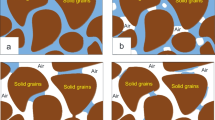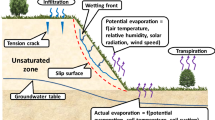Abstract
Pressure and suction plate tests are among the most common techniques for determining the soil–water characteristic curve. The required testing period depends on many parameters and equilibrium times may vary from a few minutes to several weeks. This paper presents a numerical evaluation of the equilibrium process, considering the influence of soil type, equipment specifications, the use of thin high air-entry value (HAEV) membranes, and the employment of the interrupted outflow method (IOM). A fully coupled numerical model was developed and verified for the analysis of the conservation and flow of water and air in the specimen-HAEV interface system. Verification and sensitivity analyses showed, however, that the suction and pressure plate tests may be adequately represented using a simplified decoupled version of the full model. The results of the sensitivity analysis showed not only the role of the HAEV interface characteristics, but also the effect of soil type, suction value, suction step magnitude, and the suction path. It was found that the IOM offers greater control over testing times, but may cause undesirable suction reversals within the specimen. Finally, a simple method is presented to estimate the equilibrium times using basic testing parameters.












Similar content being viewed by others
Data availability
All of the data and materials used for and obtained from the numerical models presented in this paper are available by request to the corresponding author.
Code availability
The numerical models presented in this paper are available by request to the corresponding author. A spreadsheet with the implementation of the prediction model is provided in the supporting information.
References
ASTM International (2012) Standard practice for maintaining constant relative humidity by means of aqueous solutions. ASTM E104-02. West Conshohocken, PA: ASTM International, approved 2012. https://doi.org/10.1520/E0104-02R12
ASTM International (2016) Standard test methods for determination of the soil water characteristic curve for desorption using hanging column, pressure extractor, chilled mirror hygrometer, or centrifuge. ASTM D6836-16. West Conshohocken, PA: ASTM International, approved November 15, 2016. https://doi.org/10.1520/D6836-16
ASTM International (2016) Standard test method for measurement of soil potential (suction) using filter paper. ASTM D5298-16. West Conshohocken, PA: ASTM International, approved November 15, 2016. https://doi.org/10.1520/D5298-16
Te-er B (2004) Flow of air-phase in soils and its application in emergent stabilization of slopes. Thesis, The Hong Kong University of Science and Technology MSc
Bittelli M, Flury M (2009) Errors in water retention curves determined with pressure plates. Soil Sci Soc of Am J 73(5):1453–1460. https://doi.org/10.2136/sssaj2008.0082
Brooks RH, Corey AT (1964) Hydraulic properties of porous media. Colorado State University Hydrology Papers, no. 3
Cresswell HP, Green TW, McKenzie NJ (2008) The adequacy of pressure plate apparatus for determining soil water retention. Soil Sci Soc Am J 72(1):41–49. https://doi.org/10.2136/sssaj2006.0182
Dane JH, Topp GC (2002) Methods of soil analysis—part 4 physical methods. Soil Sci Soc
Dexter AR, Czyz EA, Richard G (2012) Equilibrium, non-equilibrium and residual water: consequences for soil water retention. Geoderma Glob J Soil Sci 177–178:63–71. https://doi.org/10.1016/j.geoderma.2012.01.029
Ebrahimi-Birang N, Gitirana GFN, Fredlund DG, Fredlund MD, Samarasekera L (2004) A lower limit for the water permeability coefficient. In: Proceedings of the fifty-seventh Canadian geotechnical conference, Quebec, QC, vol 1, pp 12–19
Feuerharmel C, Gehling WYY, Bica AVD (2006) The use of filter-paper and suction-plate method for determining the soil-water characteristic curve of undisturbed colluvium soils. Geotech Test J 29(5):419–425. https://doi.org/10.1520/GTJ14004
Fourie AB, Papageorgiou G, Blight GE (1995) The Rapid determination of the moisture-retention characteristics of soil. Geotech Test J 18(2):276–285. https://doi.org/10.1520/GTJ10328J
Fredlund DG (2000) The 1999 RM Hardy Lecture: the implementation of unsaturated soil mechanics into geotechnical engineering. Can Geotech J 37(5):963–986. https://doi.org/10.1139/t00-026
Fredlund DG, Houston SL (2009) Protocol for the assessment of unsaturated soil properties in geotechnical engineering practice. Can Geotech J 46(6):694–707. https://doi.org/10.1139/T09-010
Fredlund DG, Xing A (1994) Equations for the soil–water characteristic curve. Can Geotech J 31(4):521–532. https://doi.org/10.1139/t94-061
Fredlund DG, Fredlund MD, Rahardjo H (2012) Unsaturated soil mechanics in engineering practice. Wiley, New York
Fredlund DG, Xing A, Huang S (1994) Predicting the permeability function for unsaturated soils using the soil–water characteristic curve. Can Geotech J 31(4):533–546. https://doi.org/10.1139/t94-062
Gee GW, Ward AL, Zhang ZF, Campbell GS, Mathinson J (2002) The influence of hydraulic nonequilibrium on pressure plate data. Vadose Zone J 1(1):172–178. https://doi.org/10.2113/1.1.172
Gitirana GFN Jr, Fredlund DG (2004) Soil–water characteristic curve with independent properties. J Geotech Geoenviron Eng 130(2):209–212. https://doi.org/10.1061/(ASCE)1090-0241(2004)130:2(209)
Gitirana Jr. GFN, Fredlund DG (2016) Statistical assessment of hydraulic properties of unsaturated soils. Soils Rock 39(1): 81–95. http://www.soilsandrocks.com.br/soils-androcks/SR39-1.pdf. Accessed 15 Oct 2019
Haines WB (1930) Studies in the physical properties of soil, V: the hysteresis effect in capillary properties, and the modes of moisture distribution associated therewith. J Agric Sci 20(1):97–116. https://doi.org/10.1017/S002185960008864X
Han Z, Vanapalli SK (2016) Stiffness and shear strength of unsaturated soils in relation to soil–water characteristic curve. Géotechnique 66(8):627–647. https://doi.org/10.1680/jgeot.15.P.104
Hong WT, Jung YS, Kang S, Lee JS (2016) Estimation of soil-water characteristic curves in multiple-cycles using membrane and TDR system. Materials 9(12):1–15. https://doi.org/10.3390/ma9121019
Khanzode RM, Vanapalli SK, Fredlund DG (2002) Measurement of soil-water characteristic curves for fine-grained soils using a small-scale centrifuge. Can Geotech J 39(5):1209–1217. https://doi.org/10.1139/t02-060
Leamer RW, Shaw BA (1941) A simple apparatus for measuring noncapillary porosity an extensive scale. J Am Soc Agron 33(1):1003–1008. https://doi.org/10.2134/agronj1941.00021962003300110005x
Leong EC, Rahardjo H (1997) Permeability functions for unsaturated soils. J Geotech Geoenviron Eng 123(12):1118–1126. https://doi.org/10.1061/(ASCE)1090-0241(1997)123:12(1118)
Mualen Y (1976) A new model for predicting the hydraulic conductivity of unsaturated porous media. Water Resour Res 12(3):513–522. https://doi.org/10.1029/WR012i003p00513
Ng CWW, Zhou C, Leung AK (2015) Comparisons of different suction control techniques by water retention curves: theoretical and experimental studies. Vadose Zone J 14(9):1–9. https://doi.org/10.2136/vzj2015.01.0006
Nimmo JR, Rubin J, Hammermeister DP (1987) Unsaturated flow in a centrifugal field: measurement of hydraulic conductivity and testing of Darcy’s Law. Water Resour Res 23(1):124–134. https://doi.org/10.1029/WR023i001p00124
Nishiumura T, Koseki J, Fredlund DG, Rahardjo H (2012) Microporous membrane technology for measurement of soil–water characteristic curve. Geotech Test J 35(1):201–208. https://doi.org/10.1520/GTJ103670
Oliveira OM, Marinho FAM (2006) Study of equilibration time in the pressure plate. In: Fourth international conference on unsaturated soil, Carefree, AZ 2 April, pp 1864–1874. https://doi.org/10.1061/40802(189)157
Papageorgiou G (1994) Evaluation of moisture retention and hydraulic conductivity characteristics of unsaturated soils. Thesis, University of Witwatersrand M.Sc
PDE Solutions Inc. (2009) Getting started user guide reference manual, pp 1–517
Pham HQ (2001) An engineering model of hysteresis for soil-water characteristic curves. Thesis, University of Saskatchewan M.Sc
Pham HQ, Fredlund DG, Barbour SL (2003) A practical hysteresis model for the soil-water characteristic curve for soils with negligible volume change. Geotechnique 53(2):293–298. https://doi.org/10.1680/geot.2003.53.2.293
Richards LA (1941) A pressure-membrane extraction apparatus for soil solution. Soil Sci 51(5):337–386. https://doi.org/10.1097/00010694-194105000-00005
Samingan AS, Leong EC, Rahardjo H (2003) A flexible wall permeameter for measurements of water and air coefficients of permeability of residual soils. Can Geotech J 40(3):559–574. https://doi.org/10.1139/t03-015
Schelle H, Heise L, Jänicke K, Durner W (2013) Water retention characteristics of soils over the whole moisture range: a comparison of laboratory methods. Eur J Soil Sci 64(6):814–821. https://doi.org/10.1111/ejss.12108
Tarantino A, Gallipoli D, Augarde CE, de Gennaro V, Gomez R, Laloui L, Mancuso C, El Mountassir G, Pereira JM, Peron H, Pisoni G, Romero E, Raveendiraraj A, Rojas JC, Toll DG, Tombolato S, Wheeler S (2011) Benchmark of experimental techniques for measuring and controlling suction. Geotechnique 61(4):303–312. https://doi.org/10.1680/geot.2011.61.4.303
Tripathy S, Elgabu H, Thomas, HR (2014) Soil-water characteristic curves from various laboratory techniques. In: International conference on unsaturated soil, Sydney, Australia. Unsaturated Soils: Research and Applications. CRC Press (July), pp 1701–1707. https://doi.org/10.1201/b17034-248
Wang H, Koseki J, Nishimura T, Miyashita Y (2017) Membrane filter properties and application on the filter to undrained cyclic triaxial test of unsaturated materials. Can Geotech J 54(8):1196–1202. https://doi.org/10.1139/cgj-2016-0507
Wang M, Kong L, Zang M (2015) Effects of sample dimensions and shapes on measuring soil–water characteristic curves using pressure plate. J Rock Mech Geotech Eng 7(4):463–468. https://doi.org/10.1016/j.jrmge.2015.01.002
van Genuchten MT (1980) A closed-form equation for predicting the hydraulic conductivity of unsaturated soils. Soil Sci Soc Am J 44(5):892–898. https://doi.org/10.2136/sssaj1980.03615995004400050002x
Zhai Q, Rahardjo H (2015) Estimation of permeability function from the soil-water characteristic curve. Eng Geol 199(14):148–156. https://doi.org/10.1016/j.enggeo.2015.11.001
Acknowledgements
Authors acknowledge the funding received from Coordenação de Aperfeiçoamento de Pessoal de Nível Superior—Brasil (CAPES)—Finance Code 001.
Author information
Authors and Affiliations
Corresponding author
Ethics declarations
Conflict of interest
The authors declare that they have no conflict of interest.
Additional information
Publisher's Note
Springer Nature remains neutral with regard to jurisdictional claims in published maps and institutional affiliations.
Supplementary Information
Below is the link to the electronic supplementary material.
Rights and permissions
About this article
Cite this article
Vaz, E.F., Gitirana, G.F.N., Mendes, T.A. et al. On the equilibrium of suction and pressure plate tests. Acta Geotech. 16, 2741–2758 (2021). https://doi.org/10.1007/s11440-021-01182-0
Received:
Accepted:
Published:
Issue Date:
DOI: https://doi.org/10.1007/s11440-021-01182-0




